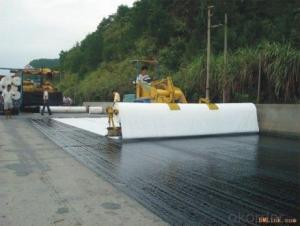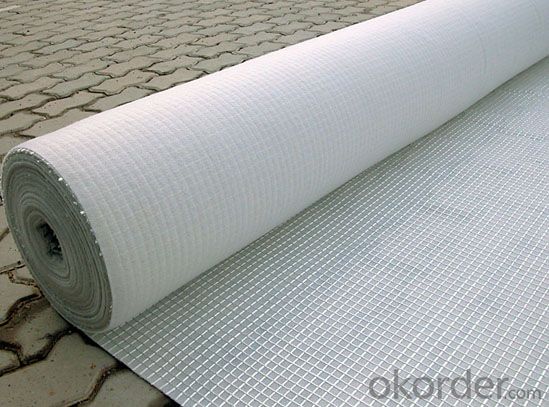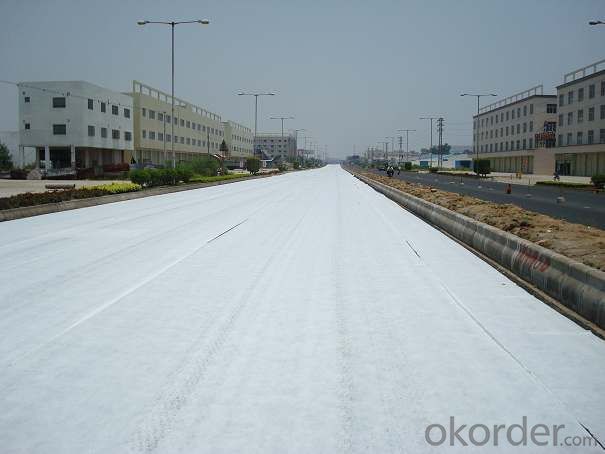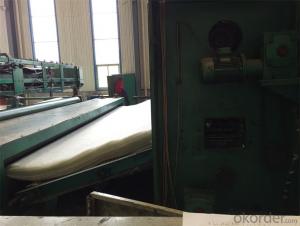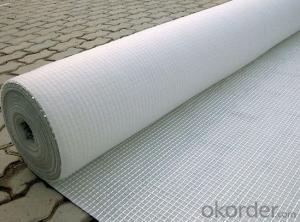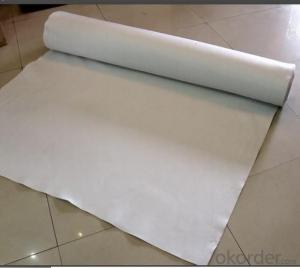Manta Geotextil Bidim Para Drenagem - Short Fiber Geotextile with Filtration of Earthwork Product
- Loading Port:
- Qingdao
- Payment Terms:
- TT or L/C
- Min Order Qty:
- 10000 m²
- Supply Capability:
- 100000 m²/month
OKorder Service Pledge
OKorder Financial Service
You Might Also Like
Road short fiber/filament geotextile
property:good flexibility,permeability,filtration,seperation
delivery in 5-7days
Specification
150gsm-800gsm
Features
good flexibility,permeability,filtration,separation and easy for constuction.
Application
It is widely used in the area of highway,railway,dam,reclamation for isolation drainage filtration and maintenance
Certificate
CE ISO9001 ISO14001
Size of pakage
width 2-6m,length 50-100m with pp film or as your request
Technical specification
item | specification | |||||||||||||||
100 | 150 | 200 | 250 | 300 | 350 | 400 | 450 | 500 | 600 | |||||||
Weight variation% | -8 | -8 | -8 | -8 | -7 | -7 | -7 | -7 | -6 | -6 | ||||||
thickness mm> | 0.9 | 1.3 | 1.7 | 2.1 | 2.4 | 2.7 | 3.0 | 3.3 | 3.6 | 4.1 | ||||||
width variation % | -0.5 | |||||||||||||||
Breaking strength KN/m> | 2.5 | 4.5 | 6.5 | 8.0 | 9.5 | 11 | 12.5 | 14 | 16 | 19 | ||||||
Elogation at break% | 25-100 | |||||||||||||||
CBR mullen brust strength KN | 0.3 | 0.6 | 0.9 | 1.2 | 1.5 | 1.8 | 2.1 | 2.4 | 2.7 | 3.2 | ||||||
Sieve size mm | 0.07-0.2 | |||||||||||||||
Tear strength | 0.08 | 0.12 | 0.16 | 0.2 | 0.24 | 0.28 | 0.33 | 0.38 | 0.42 | 0.46 | ||||||

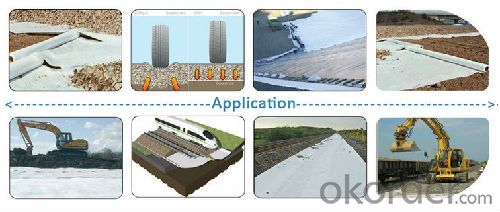
FAQ of our geotextile:
- Q: What can we do for the special customer?
A: Provide custom made service with customer's drawing; We make sure to provide you with the best solutions for your individual case. Whether standard items or non-standard items.
- Q: What can we supply?
A: We provide high levels of communication from start to finish.
- Q: What is our advantage?
A: Top Cemented Carbide has extensive business experience, Fast delivery and high quality.
- Q: What are the specifications for geotextiles used in erosion control tubes?
- The specifications for geotextiles used in erosion control tubes vary depending on the specific requirements of the project. However, common specifications include material type (typically woven or non-woven), tensile strength, permeability, UV resistance, and durability. The geotextiles should be able to retain soil particles while allowing water to pass through, effectively preventing erosion.
- Q: What are the challenges associated with geotextile installation?
- Some challenges associated with geotextile installation include: 1. Site preparation: Properly preparing the site before installing geotextiles can be challenging. It requires clearing the area of any debris, grading the surface, and ensuring a stable foundation. 2. Handling and transportation: Geotextiles can be bulky and heavy, making their handling and transportation challenging. Special equipment or manpower may be required to move and position them correctly. 3. Installation accuracy: Achieving precise alignment and placement of geotextiles is crucial for their effectiveness. It can be challenging to ensure proper positioning, especially in complex or irregular terrain. 4. Seaming and joining: Geotextiles often need to be seamed or joined together to cover larger areas. Achieving strong and reliable seams can be challenging, as it requires proper techniques and materials to ensure the integrity of the installation. 5. Durability and longevity: Geotextiles need to withstand environmental factors such as UV exposure, temperature variations, and chemical exposure. Ensuring their durability and longevity can be a challenge, as these factors can degrade the material over time. 6. Quality control: Proper quality control measures are necessary to ensure the geotextile installation meets the required standards. This includes performing regular inspections, testing, and adherence to specifications, which can be challenging to implement and maintain consistently. Overall, geotextile installation requires careful planning, skilled labor, and adherence to industry standards to overcome these challenges and achieve a successful installation.
- Q: How do geotextiles help in preventing sinkhole formation?
- Geotextiles help in preventing sinkhole formation by acting as a barrier that reinforces the soil and provides stability. They are placed beneath the soil surface to distribute the load and prevent the movement of soil particles, which is a significant cause of sinkholes. Additionally, geotextiles can improve drainage and filtration, reducing the risk of water accumulation and weakening of the soil, which can also lead to sinkhole formation.
- Q: How do geotextiles help with soil reinforcement in mechanically stabilized earth walls?
- Geotextiles help with soil reinforcement in mechanically stabilized earth walls by providing a strong and stable base for the soil. They distribute the load evenly, reducing the risk of soil erosion and increasing the wall's stability. Additionally, geotextiles improve the soil's drainage capabilities, preventing water buildup and further enhancing the wall's structural integrity.
- Q: What are the environmental impacts of geotextile production?
- The environmental impacts of geotextile production include energy consumption, greenhouse gas emissions, and potential waste generation. The manufacturing process of geotextiles requires significant energy input, often sourced from fossil fuels, leading to the release of greenhouse gases. Additionally, the extraction and processing of raw materials for geotextiles can have adverse effects on ecosystems, including habitat destruction and soil degradation. Waste generation is another concern, as the production process may generate non-recyclable or non-biodegradable waste materials. However, the use of geotextiles in various applications can also have positive environmental impacts, such as reducing soil erosion and promoting sustainable land management practices.
- Q: How do geotextiles contribute to pavement performance?
- Geotextiles contribute to pavement performance by providing reinforcement, separation, filtration, and drainage functions. They help in preventing the mixing of different layers of pavement materials, which reduces deformations and extends the lifespan of the pavement. Additionally, geotextiles improve the load-bearing capacity of the pavement by distributing the load more evenly, reducing the likelihood of cracks or failures. They also aid in filtering out fine particles, preventing clogging and maintaining proper drainage, which further enhances the pavement's durability and resistance to water damage.
- Q: How to judge the geotextile test results are reliable
- Different methods, different detection methods will lead to different results. But you can get the authority of the provincial inspection hall, do the test report
- Q: What are the key factors affecting the tensile strength of geotextiles?
- The key factors affecting the tensile strength of geotextiles include the type and quality of the material used, the manufacturing process, the thickness and weight of the geotextile, the orientation of the fibers, and the presence of any additives or coatings. Additionally, the installation and maintenance conditions, such as soil characteristics, temperature, moisture levels, and load distribution, can also impact the tensile strength of geotextiles.
- Q: How to calculate the volume weight of polypropylene nonwoven geotextile
- I professional production geotextile geomembrane and other materials, wish smooth
- Q: How do geotextiles help in preventing soil erosion in agricultural fields?
- Geotextiles help prevent soil erosion in agricultural fields by acting as a protective layer. They are placed on the soil surface to stabilize it, reducing the impact of wind and water erosion. Geotextiles effectively control the movement of soil particles while retaining water, allowing for better root development and reducing runoff. This helps to maintain the integrity of the soil and prevent erosion.
1. Manufacturer Overview
| Location | Taian City,Shandong Province,China |
| Year Established | 2008 |
| Annual Output Value | Above US$100 Million |
| Main Markets | Africa, Oceania, North America, Western Europe, Eastern Asia |
| Company Certifications | ISO9001;IS014001 Certificate |
2. Manufacturer Certificates
| a) Certification Name | |
| Range | |
| Reference | |
| Validity Period |
3. Manufacturer Capability
| a) Trade Capacity | |
| Nearest Port | Qingdao Port;Tianjing Port;Shanghai Port |
| Export Percentage | |
| No.of Employees in Trade Department | 21-30 People |
| Language Spoken: | English; Chinese; |
| b) Factory Information | |
| Factory Size: | 10,000-30,000 square meters |
| No. of Production Lines | Above 10 |
| Contract Manufacturing | Geotechnical Material (Geogrid,Fiberglass/Polyester Geogrid,Geocell,Geonet and Geomat,Plastic Safety Fence) |
| Product Price Range | Average |
Send your message to us
Manta Geotextil Bidim Para Drenagem - Short Fiber Geotextile with Filtration of Earthwork Product
- Loading Port:
- Qingdao
- Payment Terms:
- TT or L/C
- Min Order Qty:
- 10000 m²
- Supply Capability:
- 100000 m²/month
OKorder Service Pledge
OKorder Financial Service
Similar products
Hot products
Hot Searches
Related keywords
